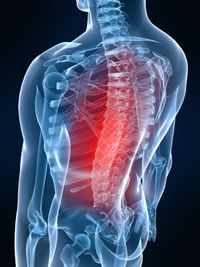
|
|
|
Call our offices at: (310) 274-3481 (800) 964-0404
Beverly Hills
9301 Wilshire Boulevard
Suite 406A
Beverly Hills, California 90210

|
|
 |
|
|
INSURANCE & WORKERS' COMPENSATION
ACCEPTED!
We accept most types of
insurance
providers and specialize in the treatment of
workers' compensation injuries to the hand and upper extremity. |
|
 |
|
Intercostal and Thoracic Pain/Upper Back Pain
Intercostal Neuralgia
Thoracic Vertebral Compression Fracture
Thoracic Radiculopathy
Manubriosternal Joint Syndrome
Costosternal Syndrome
The upper back, also referred to as the thoracic spine, is not as susceptible to injury or degeneration as the neck and lower back, however, when it does occur it can be very painful and uncomfortable. The thoracic spine is designed to be strong and stable with limited movement to protect the vital organs and allow us to stand upright. Generally, when pain is felt in the upper back it is caused by muscle strain or joint dysfunction. More serious injuries can include herniated and degenerated discs, all requiring the care of a board certified physician. Listed below are painful conditions commonly seen and treated by the physicians at Avosant Surgical Associates.

Intercostal Neuralgia
Intercostal neuralgia is a condition caused by damage or inflammation of the intercostal nerves. The pain associated is constant and burning in nature and may include any of the intercostal nerves as well as the subcostal nerve of the twelfth rib. Intercostal neuralgia is often a diagnosis of exclusion, and more life-threatening conditions must be ruled-out by a physician first. Many patients suffering from intercostal neuralgia first seek medical attention because they believe they are suffering from a heart attack or gall bladder disease. Diagnosis of intercostal neuralgia is generally based on results from plain radiographs and diagnostic nerve blocks, however, in some cases additional testing is required to rule out other conditions. Treatment of intercostal neuralgia involves the initial use of simple analgesics and nonsteroidal anti-inflammatory agents. If symptoms are not controlled, the addition of a tricyclic antidepressant or gabapentin may be added. For patients who do not respond to any of these treatment options, an intercostal nerve block may be needed. It is important for any person suspected of suffering from intercostal neuralgia to seek the care of a physician immediately.
Thoracic Vertebral Compression Fracture
Thoracic vertebral compression fracture is a condition that occurs when a bone or bones in the spine collapse. It is most common in the thoracic region of the spine and is usually caused by osteoporosis or trauma to the dorsal spine. The pain associated is determined by the severity and nature of the injury and can range from a dull, deep ache to severe sharp, stabbing pain. Thoracic vertebral compression fractures are exacerbated by coughing, movement of the dorsal spine, and deep breathing. Diagnosis of thoracic vertebral compression fracture is made on the basis of plain radiographs of the vertebra, radionuclide bone scanning if trauma is present, and bone density testing if trauma is not present. Treatment of the pain associated with thoracic vertebral compression fracture initially involves a combination of simple analgesics and nonsteroidal anti-inflammatory agents. If these medications do not control the pain, short acting potent opioid analgesics such as hydrocodone will be secondary. For patients who do not respond to these modalities, a thoracic epidural block may be needed.
Thoracic Radiculopathy
 Thoracic radiculopathy is a condition caused by compressed nerve root/s in the thoracic region of the spine and is a common cause of chest wall and upper abdominal pain. It essential for any individual experiencing abdominal or chest pain to seek immediate medical attention to ruleout life-threatening conditions. Patients suffering from thoracic radiculopathy may experience numbness, paresthesias, weakness, and occasionally, loss of superficial abdominal reflexes in the associated areas. Patients suffering from thoracic radiculopathy often experience a reflex shifting of the trunk to one side called “list”. Disc herniation, vertebral compression fractures, foraminal stenosis (narrowing of the foramen through which the nerves root exits the spinal cord), osteophyte formation (bone spurs), tumor, and rarely, infection are all causes of thoracic radiculopathy. Diagnosis for thoracic radiculopathy is based on the findings from a complete history and physical examination, an MRI or CT scan, and in some cases, patients may also need to undergo a nerve conduction study or electromyogram. Thoracic radiculopathy is best treated through a multi-disciplinary approach including the combination of physical therapy and nonsteroidal anti-inflammatory agents and skeletal muscle relaxants. In some cases, patients may also need to undergo a thoracic steroid epidural nerve block. If you believe to have thoracic radiculopathy it is extremely important to consult a qualified pain management specialist in order to receive proper diagnosis and treatment. Avosant Surgical Associates has a team of highly qualified pain management specialist that will provide the highest level of care and treatment to all patients.
Thoracic radiculopathy is a condition caused by compressed nerve root/s in the thoracic region of the spine and is a common cause of chest wall and upper abdominal pain. It essential for any individual experiencing abdominal or chest pain to seek immediate medical attention to ruleout life-threatening conditions. Patients suffering from thoracic radiculopathy may experience numbness, paresthesias, weakness, and occasionally, loss of superficial abdominal reflexes in the associated areas. Patients suffering from thoracic radiculopathy often experience a reflex shifting of the trunk to one side called “list”. Disc herniation, vertebral compression fractures, foraminal stenosis (narrowing of the foramen through which the nerves root exits the spinal cord), osteophyte formation (bone spurs), tumor, and rarely, infection are all causes of thoracic radiculopathy. Diagnosis for thoracic radiculopathy is based on the findings from a complete history and physical examination, an MRI or CT scan, and in some cases, patients may also need to undergo a nerve conduction study or electromyogram. Thoracic radiculopathy is best treated through a multi-disciplinary approach including the combination of physical therapy and nonsteroidal anti-inflammatory agents and skeletal muscle relaxants. In some cases, patients may also need to undergo a thoracic steroid epidural nerve block. If you believe to have thoracic radiculopathy it is extremely important to consult a qualified pain management specialist in order to receive proper diagnosis and treatment. Avosant Surgical Associates has a team of highly qualified pain management specialist that will provide the highest level of care and treatment to all patients.
Manubriosternal Joint Syndrome
The manubriosternal joint connects the body of your sternum and the manubrium (bone that articulates with the sternal ends of the clavicle and the cartilage of the first rib). It is a fibrocartilaginous joint that lacks a true joint cavity and allows protraction and retraction of the thorax. The manubriosternal joint is susceptible to arthritis and invasion by tumor. The manubriosternal joint is often traumatized during acceleration/deceleration injuries and blunt trauma to the chest resulting in dislocation and/or acute inflammation. The pain associated with manubriosternal joint syndrome often mimics that of cardiac origin, and therefore immediate medical evaluation is necessary to rule out ischemic heart disease or other life-threatening problems. Patients suffering from manubriosternal joint syndrome complain of pain when raising the arms, on deep inspiration, protracting and retracting the shoulders, and shrugging the shoulders. Often patients report a clicking sensation when the joint is moved. Diagnosis of manubriosternal joint syndrome is based on the findings from plain radiographs. Additional testing may be needed including an MRI, blood tests, and possible injection of the manubriosternal joint. Initial treatment for the pain associated with manubriosternal joint syndrome includes a combination of nonsteroidal anti-inflammatory agents, the use of heat and cold compresses, as well as an elastic rib belt should provide some relief. In some cases, patients do not respond to these modalities and may require injection of the manubriosternal joint for further relief. Diagnosis from a professional, qualified pain management specialist is essential in the treatment of manubriosternal joint syndrome.
Costosternal Syndrome
Costosternal syndrome is a condition caused by inflammation of the cartilage that connects the inner ribs to the sternum (breast bone). This inflammation can be caused by trauma from acceleration/deceleration injuries or blunt trauma to the chest wall, severe trauma may cause the joints to dislocate. The costosternal joints are susceptible to arthritis. Chest pain of other etiology including heart, lung, and esophageal disease must always be ruled-out first by thorough evaluation by a physician. Patients suffering from costosternal syndrome complain of pain when raising the arms, deep breathing, protraction and retraction of the shoulders, and shrugging the shoulders. Patients also complain of difficulty coughing, joint and intercostal muscle sensitivity, and a clicking sensation when moving the joint. Costosternal syndrome is diagnosed by history and physical examination and on the results of plain radiographs. Additional testing may be required such as bone scanning and MRI depending on alternate indications. Initial treatment for the pain associated with costosternal syndrome includes a combination of nonsteroidal anti-inflammatory agents, the use of heat and cold compresses, and an elastic rib belt. For patients who do not respond to the previous modalities, injection of the costosternal joints may be required. It is advised to seek medical attention from a qualified pain management specialist, like the professionals at Avosant Surgical Associates, to receive a proper diagnosis and treatment if you believe to be suffering from costosternal syndrome.

Top of the Page |
|